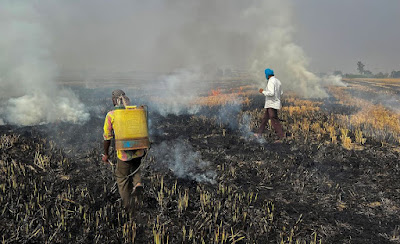 |
| Farmers burn crop stubble in a rice field at a village in Fatehgarh Sahib district in the northern state of Punjab, India, November 4, 2022. REUTERS/Sunil Kataria |
The Victorian department of agriculture describes current Australian farm practices for stubble management in wheat cropping. A number of options are discussed.
For example, at "Crops and horticulture - Managing stubble",
Crop stubble is the straw and crown of plants left on the soil surface after harvest. Stubble also includes straw and chaff discharged from the harvester (header). It is also known as ‘residue’ or ‘trash’.A new piece of information discussed by a Canadian soil scientist - that spreading plant material with a high carbon:nitrogen ratio before it has been composted - can reduce soil nitrogen.
Stubble management is one of many complex issues that farmers must contend with. Traditionally, grain growers have burnt stubble to manage weeds, diseases and reduce biomass to make sowing easier. This is no longer the preferred option. Numerous other methods can be used to manage stubble.
Retaining stubble, rather than burning or cultivating, protects the soil from erosion. It also conserves soil moisture and organic matter to sustain crop production. This is particularly beneficial in dry areas or in dry seasons.
Old tree leaves are a staple of fall but it seems wasteful to simply throw them into the garbage. However, applying these [and wheat stubble] to your garden the wrong way can be equally as damaging to your soil nutrients. This article looks at how to use old tree leaves in your garden properly.
If it is true that the same process occurs, reducing soil nitrogen with wheat stubble retained in fields after harvesting, the result will be an increased need for nitrogen fertiliser.
Nitrogen fertilisers are increasingly expensive, and most are made from natural gas with significant carbon dioxide emissions.
The soil scientist's advice suggests the need for nitrogen fertiliser may be lowered by harvest wheat stubble and compost it with fungi before spreading the composted stubble on fields.
A small-scale experiment could evaluate the potential benefit of harvesting wheat stubble instead of leaving it to compost in contact with fields, and then spreading the composted wheat stubble to return nutrients and to increase soil carbon.
Work on this possibility has been completed in India:
The smog choking New Delhi has been linked to the burning of crop stubble. Every year, most farmers in North India clear their paddy fields by burning an estimated 23 million tonnes of straw. This year, local officials have introduced a revolutionary method in a bid to tackle air pollution. Developed by the Indian Agricultural Research Institute, the bio-decomposer mixture of fungus, jaggery [an unrefined sugar product made in Asia], gram flour and water can help break down the stubble and turn it into compost that will help fertilise the land in just two to three weeks.

0 comments:
Post a Comment